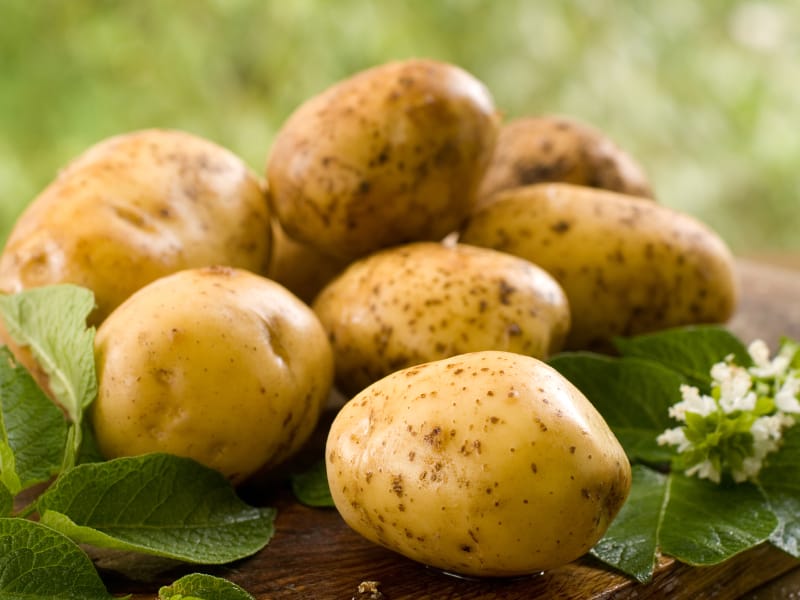Scalloped, sautéed, baked, roasted, French-fried, cottage-fried; in a hash, in a stew, in a gratin, as a soup, with a roast—the potato can do all this and more. And now this versatile root vegetable —once all but eliminated from our regular menu rotation—is making a comeback.
Why did we start avoiding potatoes in the first place? Well, there was all that talk about white foods being the food of the devil, and good ol’ russet and red potatoes got thrown in the same category. But while it’s true that foods such as white bread don’t offer much by way of nutrition—and are avoided at all cost around our house—the humble potato boasts a decent nutrition profile. Because of that, we’ve welcomed it back with open arms.
According to Sally Fallon’s Nourishing Traditions, here’s what the potato brings to the table, quite literally:
- Vitamin C
- Vitamin B complex
- Potassium
- Calcium
- Iron
- Fiber (in the skins)
Another bonus about the potato? It’s a perfect open canvas. With its mild flavor, a potato won’t overpower the dish it’s added to—but with just a few key ingredients, it can become the most sought-after item on the table. I’m thinking of potatoes sautéed with onions, butter, salt, and pepper. Or one of my personal favorites—a simple pot roast with the potatoes and carrots tossed right in the same pan as the roast. After cooking for more than an hour, the potatoes soak up the lovely juices from the roast and take on a scrumptious new flavor that needs nothing but a pat of butter, if you feel so inclined. A craving for this very dish on my last birthday kicked off my renewed love affair with potatoes. It was something my mom made pretty regularly when I was growing up, and has since become a comfort food of mine. That morning I called her for the recipe, and by the time I ate it that night I was right back at the table with my whole family as a little girl. That’s the power of food.
Sally Fallon offers up a few tips and factoids to keep in mind when considering adding potatoes to your meals:
- Leave the skins on whenever possible. That’s where you’ll find most of the nutrients listed above.
- Buy organic. This is especially important when it comes to potatoes, as their commercially grown counterparts are typically treated with a sprout inhibitor known to cause cellular changes in test animals.
- Store in a cool, dark place—but not the refrigerator. Extreme cold will turn the starch into sugar. Also, too much light causes potatoes to sprout. (A note on sprouts—these shouldn’t be eaten as they contain poisonous alkaloids. However, if the sprouts are still small, the potato should be safe to eat once they’ve been cut off.)
- Potatoes contain chlorogenic acid, a chemical that prevents cell mutations leading to cancer.
- In the past, doctors in America recommended potatoes for purifying the blood and curing indigestion.
- A cautionary note: potatoes may not be the best choice for diabetics as they can quickly raise blood sugar levels in some individuals.
In his 1943 paper “Recent Conclusions in Malnutrition,” Dr. Royal Lee also sings the praises of the humble potato. He notes that it’s a valuable source of vitamin C, containing a third as much as found in an orange. Lee also points out that the potato is one of only a handful of foods that can indefinitely sustain human life on its own, backing up his claim with a reference to an Irish prison where inmates were fed nothing but potatoes for ninety days. By the end of the study, the prisoners were all found to have gained weight and were even healthier than when they arrived. Of course, I’d never recommend this strategy—just as I’d never recommend avoiding them completely.
I bet that any cookbook focusing on real foods and traditional cooking methods would have several pages dedicated to the potato and how it can benefit you in the kitchen. Here’s a simple but interesting tip from the Dining on a Dime Cookbook, by Tawra Kellam and Jill Cooper: if your dish is overly salted, simply drop a peeled potato into it while it’s still cooking. The potato will absorb the excess salt, and the dish will be saved. Neat-o, eh?
What’s one of your favorite humble foods—and your favorite way to prepare it?
Photo from iStock/Wiktory



